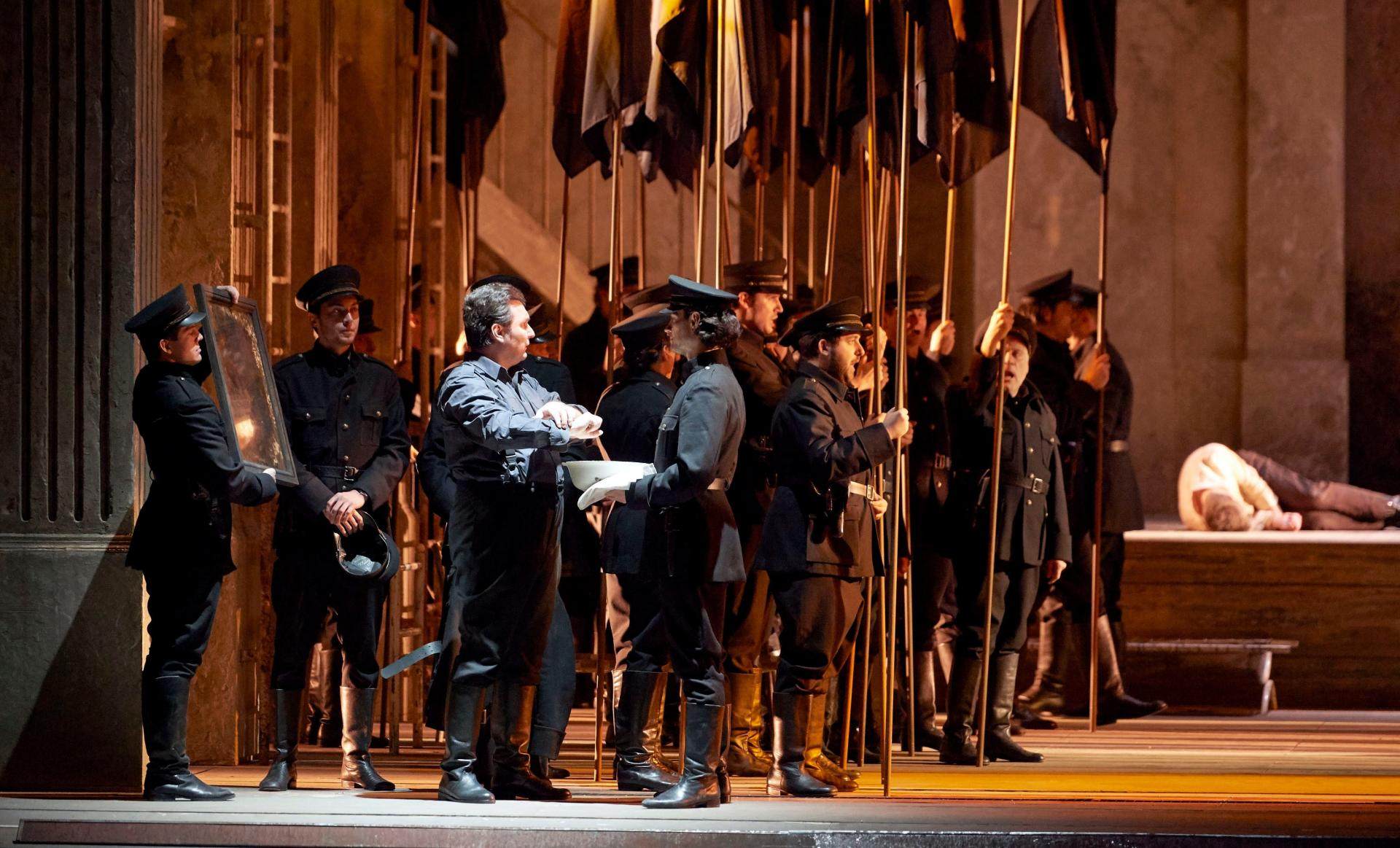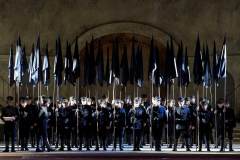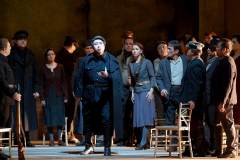Il Trovatore
Mo | Tu | We | Th | Fr | Sa | Su |
BACKSTORY
The former Spanish Count Luna once had an old woman burned at the stake,
because he accused her of bewitching his younger son, little Garcia. In revenge, Azucena, the woman's daughter, kidnapped Garcia. Shortly afterwards, the charred remains of a burnt child were found. The old count could not believe that Garcia was dead and, before he died, made his elder son swear never to give up the search for his missing brother.
ACT 1
15 years later, a civil war rages in Spain,
in which the remaining elder son and now Count Luna takes part militarily. The troubadour Manrico, who believes himself to be the son of Azucena, fights on the opposite side.
Manrico and Luna also face each other on the field of love: Both love the lady-in-waiting Leonora, who in turn is in love with Manrico. One night, Leonora hears Manrico singing a song in the immediate vicinity of the palace gardens and wants to hurry towards him. Deceived by the darkness, she recognizes the man she throws herself into the arms of too late - Count Luna, who must now learn that Leonora loves Manrico. Luna therefore challenges Manrico, who has also rushed over, to a duel. Luna loses, but is pardoned by Manrico.
ACT 2 & 3
Some time later, Manrico witnesses a vision of Azucena in which she relives her mother's death at the stake.
No longer in control of her senses, Azucena confesses that she vindictively burned a child - her own and not the stolen one - out of a terrible mistake. However, she knows how to calm Manrico's emerging doubts: He is her son.
When Leonora receives the false report that Manrico has fallen, she decides to go to the convent. To prevent this, Luna tries to kidnap her, but is stopped by Manrico, who seizes the opportunity and flees with Leonora to the Castellor fortress, of which he has been appointed commander.
when Azucena tries to make her way to Manrico, she is picked up by Luna's men. Manrico makes an attempt to free her, but also falls into the hands of his enemies.
ACT 4
The desperate Leonora offers herself to Luna as a prize if he pardons Manrico
Luna happily accepts the offer, unaware that Leonora is taking poison to escape a life with the unloved count. She manages to tell her beloved Manrico that she has been freed before she dies in his arms. The furious Luna then orders Manrico to be executed. As soon as this has been carried out, Azucena hurls the words "He was your brother" at him.
ACT 1 & 2 - 75 MIN
INTERMISSION - 25 MIN
ACT 3 & 4 - 65 MIN
Program and cast
Il Conte di Luna: Artur Rucinski; Luca Salsi*
Leonora: Maria Agresta; Krassimira Stoyanova*
Azucena: Clémentine Margaine; Ekaterina Semenchuk*
Manrico: Vittorio Grigolo; Piotr Beczala*
Ferrando: Ilja Kazakov; Dmitry Ulyanov*
Conductor: Pier Giorgio Morandi; Marco Armiliato*
Director: Daniele Abbado
Set Design: Graziano Gregori
Costumes: Carla Teti
Lighting: Alessandro Carletti
Directorial Assistance: Boris Stetka
Set Design Assistance: Angelo Linzalata
*May 18, 2025; May 21, 2025; May 24, 2025; May 27, 2025; May 30, 2025
Vienna State Opera
Public Transport
Subway lines: U1, U2, U4
Trams: 1, 2, D, J, 62, 65
Buses: 59A
Local Railway: Badner Bahn
Stops: Karlsplatz / Opera
Taxi stands are available nearby.
Parking
Parking is only € 6, - for eight hours!
The Wiener Staatsoper and the ÖPARK Kärntner Ring Garage on Mahlerstraße 8, under the “Ringstraßengalerien”, offer the patrons of the Vienna State Opera a new, reduced parking fee. You can park in the Kärntner Ring Garage for up to 8 hours and pay only a flat fee of € 6, -. Just validate your ticket at one of the discount machines inside the Wiener Staatsoper. The normal rate will be charged for parking time greater than 8 hours. The validation machines can be found at the following coat checks: Operngasse, Herbert von Karajan-Platz, and the right and left and balcony galleries.
Important: In order to get the discount, please draw a ticket and do not use your credit card when entering the garage!
After devaluing your ticket in the Wiener Staatsoper you can pay comfortably by credit card or cash at the vending machines.
The machines accept coins and bills up to 50.- Euro. Parking time longer than 8 hours will be charged at the normal rate.
History
The structure of the opera house was planned by the Viennese architect August Sicard von Sicardsburg, while the inside was designed by interior decorator Eduard van der Nüll. It was also impacted by other major artists such as Moritz von Schwind, who painted the frescoes in the foyer, and the famous "Zauberflöten" (“Magic Flute”) series of frescoes on the veranda. Neither of the architects survived to see the opening of ‘their’ opera house: the sensitive van der Nüll committed suicide, and his friend Sicardsburg died of a stroke soon afterwards.
On May 25, 1869, the opera house solemnly opened with Mozart's Don Giovanni in the presence of Emperor Franz Joseph and Empress Elisabeth.
The popularity of the building grew under the artistic influence of the first directors: Franz von Dingelstedt, Johann Herbeck, Franz Jauner, and Wilhelm Jahn. The Vienna opera experienced its first high point under the direction of Gustav Mahler. He completely transformed the outdated performance system, increased the precision and timing of the performances, and also utilized the experience of other noteworthy artists, such as Alfred Roller, for the formation of new stage aesthetics.
The years 1938 to 1945 were a dark chapter in the history of the opera house. Under the Nazis, many members of the house were driven out, pursued, and killed, and many works were not allowed to be played.
On March 12, 1945, the opera house was devastated during a bombing, but on May 1, 1945, the “State Opera in the Volksoper” opened with a performance of Mozart's THE MARRIAGE OF FIGARO. On October 6, 1945, the hastily restored “Theaters an der Wien” reopened with Beethoven's FIDELIO. For the next ten years the Vienna State Opera operated in two venues while the true headquarters was being rebuilt at a great expense.
The Secretary of State for Public Works, Julius Raab, announced on May 24, 1945, that reconstruction of the Vienna State Opera would begin immediately. Only the main facade, the grand staircase, and the Schwind Foyer had been spared from the bombs. On November 5, 1955, the Vienna State Opera reopened with a new auditorium and modernized technology. Under the direction of Karl Böhm, Beethoven’s FIDELIO was brilliantly performed, and the opening ceremonies were broadcast by Austrian television. The whole world understood that life was beginning again for this country that had just regained its independence.
Today, the Vienna State Opera is considered one of the most important opera houses in the world; in particular, it is the house with the largest repertoire. It has been under the direction of Dominique Meyer since September 1, 2010.

 EN
EN DE
DE IT
IT FR
FR ES
ES RU
RU JP
JP RO
RO
 Seating plan
Seating plan 

